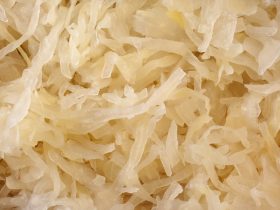Pepperoni is, contrary to popular belief, actually a mixture of pork and beef, and not in fact only pig meat. Cured and heavily seasoned, pepperoni is popular as both a topping and as a main ingredient in dishes like sub sandwiches and pasta.
With a distinctly smoky and savory flavor, pepperoni is often cured in large tubes in order to cut packaging and curing costs, boosting the profit margins of the butcher or meat processing manufacturer. Produced and purchased in such large volumes, home chefs and manufacturing executives may find themselves both asking; can you freeze pepperoni?
Being a dried and cured meat product, pepperoni freezes extremely well, making it an excellent candidate for long-term storage in your freezer. This, of course, only applies to pepperoni by itself, and pepperoni meat products that contain vegetables, cheese, or other ingredients that are not ordinarily added to it will expire far faster.
What Do You Need to Freeze Pepperoni?
Choosing to freeze pepperoni is otherwise unnecessary if the pepperoni has not been removed from its original packaging, as simple refrigeration is sufficient enough to store the still-packaged pepperoni for quite a length of time.
However, if the pepperoni has already been exposed to the open air by removing it from its original packaging, freezing it will allow the pepperoni to last for up to ten months, depending on the degree to which the meat has been dried and cured as well as the storage procedures used while preserving it.

In order to freeze pepperoni that has already been opened, you will require aluminum foil as well as resealable plastic pouches or freezer bags. A freezer capable of reaching temperatures at or below 32°F is also needed.
How to Freeze Pepperoni
To begin freezing your pepperoni, first slice it into manageable pieces. This is not required, but will make defrosting and storing the cured meat far easier. Cutting the pepperoni tube will also extend its shelf-life, as repeatedly removing the entirety of the pepperoni from the freezer then subsequently returning it will drastically shorten its shelf-life.
Once the pepperoni has been cut into suitably sized pieces, pile your desired serving size into individual sheets of aluminum foil. The aluminum foil will act as the last line of defense against freezer burn, which will alter the pepperoni’s taste and quality significantly.
Separate the individual serving size batches of pepperoni into different freezer bags or resealable plastic pouches, pushing out as much air as possible from within. Pepperoni is highly susceptible to oxidation, which will make it stale and reduce the presence of its smoky flavors.
Now insulated from the freezer’s environment by two layers, pile the bags in the deepest part of your freezer for up to ten months.
Can Dried Pepperoni be Kept at Room Temperature?
Dry pepperoni may be kept at room temperature if certain conditions are met, though we advise storing it in the refrigerator or freezer instead as the shelf-life of pepperoni in your pantry or cupboard is nowhere near as long as it would be when stored elsewhere.
In order to ensure that the pepperoni does not develop bacterial or fungal cultures, keep it sealed in its original container. Store this container in a dry and cool corner of your kitchen or pantry, since excess moisture or heat may both compromise the packaging and alter the quality of the meat.
Do not expose the container of pepperoni to direct sunlight either, as this will not only completely dehydrate the meat but also cause any lipids within to separate, depending on the ambient temperature of the storage room.
Stored unexposed to the open air and in the proper conditions, your pepperoni should last for up to a month before showing signs of spoilage or loss of quality.
Can You Refrigerate Pepperoni?
According to an informational bulletin posted by the U.S. Department of Agriculture, dried and hardened meats can be stored for a significantly long length of time, so long as they are left whole and intact with them never being removed from their original packaging2.
This is due to the fact that packaged pepperoni is often treated with bacteriostatic preservatives, apart from the benefit that the pepperoni itself is hostile to most forms of microbiological life owing to its lack of moisture.
Despite this, it is best to store the unopened package of pepperoni in the driest and deepest part of your refrigerator in order to avoid possible condensation from forming within the packaging.
However, if you have already opened the packaging and exposed the pepperoni to the open air, it is likely that it will not last an indefinite amount of time in the refrigerator.
Once opened, we advise storing the pepperoni in an air-tight and dry container free of other ingredients that may cause the pepperoni to absorb their odors. Store this container in much the same way you would store the package of unopened pepperoni – in the driest section of your refrigerator.
Opened pepperoni that has been placed in the refrigerator can last for up to three weeks before spoiling.
Does Curing Pepperoni Keep It from Going Bad?
Bacteria and fungi, much like other forms of life, require moisture in order to survive. This is all the more so for the type of microorganisms that colonize foodstuffs, as even tiny amounts of moisture can be sufficient enough to allow for propagation of these microbes.
Curing meats involves placing the meat over smoke in order to dehydrate the meat and produce a smoke-particulate coating over its surface, essentially acting as an insulating layer against the microscopic bacteria and fungi, keeping them from taking root on the meat.
And while curing meat does indeed provide a difficult environment for these microbes to colonize, it is not a fool-proof technique, and particularly hardy species (or even ordinary microbes given enough time) will eventually cause the meat to spoil.
Keep in mind that this significant extension of shelf-life is shortened by a large margin once the meat has been removed from its original packaging, as moisture and oxygen in the air will counteract many of the beneficial effects from curing the meat.
How to Know if Pepperoni has Gone Bad
Unlike other forms of meat, pepperoni’s dry nature means that it is sometimes difficult to determine whether it has begun to spoil or not. Fortunately, there are a few telltale signs that can indicate not only whether it has gone bad, but also the particular reason behind this spoilage.
Off-color patches or abnormal growths along the meat’s surface are often a sign of fungal colonization, meaning that the pepperoni has either been left in a moisture-rich environment or has otherwise been stored for too long a period after being removed from its original packaging.
It is best to throw out the entirety of the pepperoni after noticing these signs.
Apart from visual indicators, if the pepperoni develops a rotten or otherwise unpleasant smell, it is likely that the lipid compounds within the meat have undergone oxidation after being exposed to the open air. While not necessarily a sign of bacterial or fungal growth, it is still best to dispose of the pepperoni.
Pepperoni may darken in color somewhat if it is stored for extended periods in the refrigerator or freezer. This is not a sign of spoilage, and the pepperoni is still entirely edible so long as it does not display any other signs of spoilage.
References
1. Moskin, Julia (February 1, 2011). “Pepperoni: America’s Favorite Topping”. The New York Times.
2. Unknown Author. (July 2019) “How long can pepperoni be used after opening the package?” U.S. Department of Agriculture AskUSDA





Hi, I'm Dom
Dom Eats was started to help other people fall in love with food. While cooking can feel intimidating, it doesn't have to be.